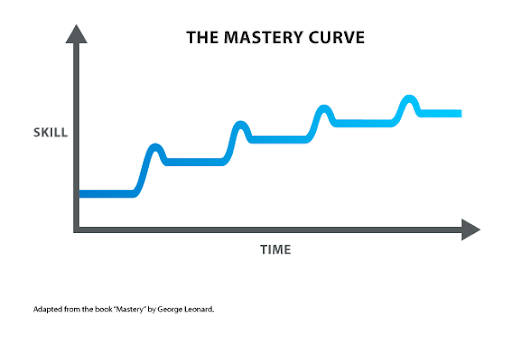Intuitive Learning and the Art of Shovelry
By Grant Kegel
You know what I dislike? Learning. Sixteen years of my life in classes and what do I have to show for it? A degree, and a barely functioning understanding of Microsoft Word. You know what is better than learning? Video games. Digital worlds perfectly designed for escapism. And don’t we all need an escape from reality sometimes?
George Leonard’s Mastery Curve from “Mastery: The Keys to Success and Long-Term Fulfillment”
I hardly need to say it, but learning is frustrating! You can see the mountain top, where you want to be; and then you scan your eyes along the crag-filled crawl to get there. If you look up diagrams of learning and mastery of a skill over time, the start is incredibly slow, whereas being mediocre is fairly rapid. But as for mastery, it becomes tedious, an everlasting journey to be just one iota better. Exiting Plato’s cave often seems barely worth the effort.
The ironic thing about loving video games like myself is that they work very hard to teach us. And I’m not talking solely about CoolMathGames.com. Putting aside edutainment programs, consider the structure of a video game - simple challenges slowly ramping in difficulty until a final test of ability. It’s a steady honing of skills over time! It just so happens that many of those skills are completely useless in the real world, much to my parent’s displeasure.
So in what ways do video games teach us? Well, obviously, trivia games and the like teach us facts and bits of useless knowledge to lord over others at parties. But more generally, games teach us how to manipulate and explore a virtual space in order to overcome specific roadblocks. Teaching how to explore is a game’s most important job, for without it, the player would be unable to see the carefully coded experience laid out by the developers.
Minecraft. Gif courtesy of author
To speak less esoterically, I’m talking about the physical controls of a game. Controls are something people like me who’ve spent a great deal of their lives playing video games take for granted. Many controls are fairly uniform, depending on genre, due to generations of game development, play-testing, and convention forming. A = jump, X = Attack, WASD are directional inputs on a 2D platformer for PC, and if you’ve ever played a single FPS before, you know right trigger is “shoot the bad guy”. Every single one. Even Minecraft Steve is in on it.
But let’s stay away from 3D worlds for now. I find when introducing somebody to video games, they find 2D to be more understandable to explore than 3D. There’s something about taking away the z-axis and just side-scrolling the screen that is far more graspable. You’ve removed a plane of existence, and as such, a whole dimension you no longer have to worry about.
Controls vary from game to game, but something else that changes drastically between games is how it goes about teaching controls. Sometimes you’ll get a few text boxes shooting by with buttons in a dialogue sequence. Sometimes you’ll get a base level where the structure of the game is limited to all but the barest of controls. Effectively, a play pen/testing area. And in the worst cases, you’ll just get one of these:
A completely incomprehensible babble of controls that the player will have to check about twenty times before they do the action they’re trying to do. It’s entirely indigestible to someone who doesn’t play games. Control maps are good for referencing mid-game, but as introductory material, it is off-putting, lazy, and mentally taxing on the player who now has to memorize fifteen different button inputs at once before being dropped in.
With all this in mind, know what’s great? A game that teaches you how to play without even explicitly telling you how to. Maybe a button press here and there, but besides that, when a game allows you, the player, to find and forge your own relationship to the controls, it is far more natural, and most importantly, fun! This is called implicit learning, which is learning something without explicit instruction. You go from not-knowing to knowing suddenly after trying for only a bit, and never forget. Real life examples include learning to swim or riding a bike - once you can you can’t imagine not knowing how to, you feel it in every part of your body implicitly. The concept is simple, and you learn it fully without much advanced tutelage.
Which brings me to the love letter in this piece, to a very excellent game that demonstrates implicit learning incredibly well. That game is Shovel Knight, developed in 2014 by Yacht Club Games.
Shovel Knight itself is a love letter, being a 8-Bit 2D platformer stylized after the games of yesteryear, starring a particularly blue paladin on a quest, armed only with his trusty spade. It is a fantastic game, from top to bottom. I’ve played it from beginning to end multiple times with multiple friends, and it always stuns me how quickly they learn the controls. This in large part due to a masterfully designed first level.
When you start the first level, you aren’t given any directive. If a player, new to Shovel Knight, or games in general, randomly pressed buttons, they’d eventually press left or right, and find themselves walking in that direction. In that spam of buttons, they’d probably hit one of the three buttons that cause Shovel Knight to attack in front of him. The first thing the player encounters is that little pile of gold and rubble on the right side of the screen. If a player decides to attack it, they would find they can dig up gold from it! And if that weren’t enough, if the player were to continue running right, they’d run into a slowly moving bug enemy, that they could once again attempt to attack.
At this point, the player has already figured out how to attack and move horizontally. And even if they managed just to damage through the enemy without learning how to attack, they are greeted with the next implicit learning roadblock:
The dreaded ledge. Here, Shovel Knight will rust and starve away forever unless the player learns how to jump, or the “A” button. And then, even more terrifyingly, they’ll have to do it AGAIN, IMMEDIATELY!
I won’t go into any further detail, but this pattern of observation, experimentation, and repetition as a means to implicitly teach players game mechanics is worked throughout the entirety of Shovel Knight’s first level, and indeed, the game as a whole. This makes learning the controls and mechanics not just easy and intuitive, it makes it enjoyable!
Obviously it goes without saying that this method of teaching and learning is a product of Shovel Knight’s genre choice- two-dimensional platforming is a fairly intuitive and simple design that players are able to pick up quickly. Level 1-1 in the original Super Mario Bros is seen as so brilliantly designed for all the reasons listed here for Shovel Knight, but 29 years earlier! The developers of today are rehashing the lessons of yesterday, and it isn’t one bit less fun to experience the process of picking up a new game and learning it.
So the next time you’re stomping on goombas or swinging a cerulean shovel, I hope you consider the time it took to teach you the skills you needed to adventure into your chosen digital landscape!
And if you haven’t yet, please, play Shovel Knight. The journey is worth every minute.







